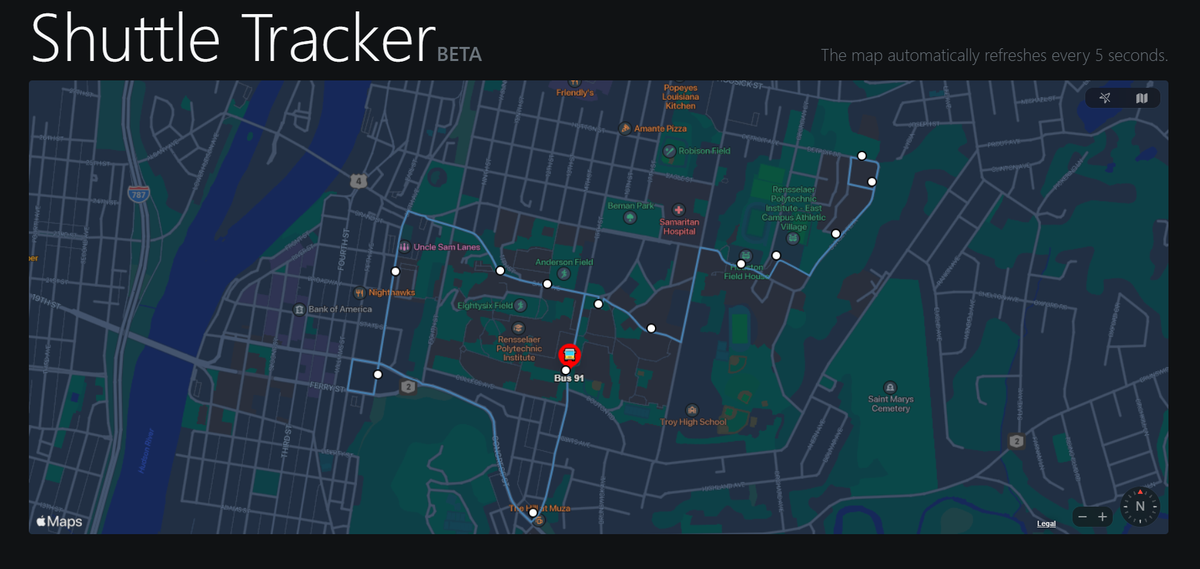New Shuttle Tracker enters beta

Shuttle Tracker recently released a new public beta, called “the new Shuttle Tracker,” with a major new feature: crowd-sourced location data. Shuttle Tracker, a website that’s been mapping and tracking RPI’s shuttle buses since 2009, is one of the oldest projects developed by the Rensselaer Center for Open Source. The Polytechnic interviewed the Shuttle Tracker team on the Tracker's new features.
When highlighting the changes, project lead Gabriel Jacoby-Cooper ’24 explained the reason for improving Shuttle Tracker by giving an example of a student running down to catch a shuttle, only to find out “that [data] was from two minutes ago, [and] by the time you get downstairs, it has already passed by—that sucks and we want to fix that.” As alluded to by Jacoby-Cooper, the GPS data gathered by Shuttle Tracker from the campus shuttles only updates every few minutes. Shuttle Tracker team plans to fix this by using “the GPS hardware that's already in everyone’s pockets: their cell phones. By building native apps for iOS and Android, [we] will allow users to contribute to better location accuracy for all users.” Jacoby-Cooper also pointed out that the application for iOS is already in beta and can be downloaded—while its Android counterpart is still being developed. He explained that the two applications will strive to have feature parity, meaning the two different platforms will hopefully have the same capabilities.
The question of privacy and security arose with the talk of using location data. When asked about this, the Shuttle Tracker team explained some design considerations implemented to address these concerns. For example, Shuttle Tracker only tracks the user’s location data when the user hits the “Board Bus” button on the app and ends when the user hits the “Leave Bus” button. The user’s location data, which is sent every five seconds, is not directly tied to any specific individual, as only an instance-specific random identifier is sent to the server, which is used to track when the data becomes expired. Furthermore, data points older than 30 seconds are automatically discarded. Shuttle Tracker also has an internal policy against using any third party APIs, aside from necessary APIs such as Apple Maps and Google Maps for displaying the data, and instead aims to keep everything in-house. For the curious, further details can be found within the Shuttle Tracker application, which displays an explanation of all data collected by the app and the policy for the collection and handling of that data.
The new Shuttle Tracker also has additional design and feature changes currently in the beta. Most notably, the beta’s web interface is significantly less cluttered and more utilitarian. The Shuttle Tracker team explained that this change was the direct result of user feedback, since most users use the website on their mobile devices, which have smaller screen real estate. The new Shuttle Tracker also strives to have a native user experience by using Apple Maps for Apple devices and Google Maps for Android devices. Algorithmically, the new Shuttle Tracker now tries to evaluate the quality of the location data and indicates this to the end user through displaying red and green buttons, with green indicating high-quality data and red indicating low-quality data. The Shuttle Tracker team says that this feature will become significantly more important as more users start to contribute location data.
In the future, Shuttle Tracker plans to implement App Clips on iOS and Instant Apps on Android which would allow Shuttle Tracker to temporarily run on a user’s device without needing to be installed as a means to increase adoption of the crowd-sourcing feature. However, the team stresses that this would require gaining approval from The Office of Parking and Transportation to post the necessary QR codes or NFC tags at shuttle stops. The team is also actively considering ways to incentivize users to use location tracking such as community milestones or, with the user’s permission, rankings. One feature that was removed in the beta is directional data to indicate where the shuttle is headed. The team explained that this feature will likely come back in future updates.
Some users may have noticed that the new Shuttle Tracker has been switched in and out with the old version of Shuttle Tracker several times as the active version on the Shuttle Tracker website. When asked about this, Jacoby-Cooper cited internal politics as the primary reason, explaining that “Shuttle Tracker is an RCOS project, but it’s not managed independently…[it] is managed by student government, specifically, the WebTech committee…[and] they had some concerns with the old Shuttle Tracker and wanted us to redirect to the new one…Later on, they fixed something with the old Shuttle Tracker, and they asked us to remove the redirect.
He explained that the Shuttle Tracker beta will replace the old version eventually, pending bug fixes and improvements such as compatibility with older web browsers. Shuttle Tracker’s beta has also had some issues with server-side reliability. However, the team stresses these types of issues are to be expected, are actively managed, and do not impact functionality as the old Shuttle Tracker remains active.
When asked about RCOS in general, Jacoby-Cooper stated, “RCOS is great,” furthering that “Shuttle Tracker is a great testament to strength of RCOS…At many schools, cool projects that students build for other students die quickly as soon as they graduate…Projects get passed down in a formal way [here].” The Shuttle Tracker team encourages anyone interested in programming to join RCOS while specifically welcoming any possible new members. If anyone is interested in joining RCOS meetings are held in Sage on Tuesday and Friday from 4–6 pm for the specific project that interests them. RCOS is also available to take for academic credit through class registration.

 Editorial Notebook
Editorial Notebook
 Editorial Notebook
Editorial Notebook